Discover 35 hidden attractions, cool sights, and unusual things to do in Busan (South Korea). Don't miss out on these must-see attractions: Jagalchi Market, Beomeosa, and Yongdusan Park. Also, be sure to include SEA LIFE Busan Aquarium in your itinerary.
Below, you can find the list of the most amazing places you should visit in Busan (Busan).
Table of Contents
Jagalchi Market
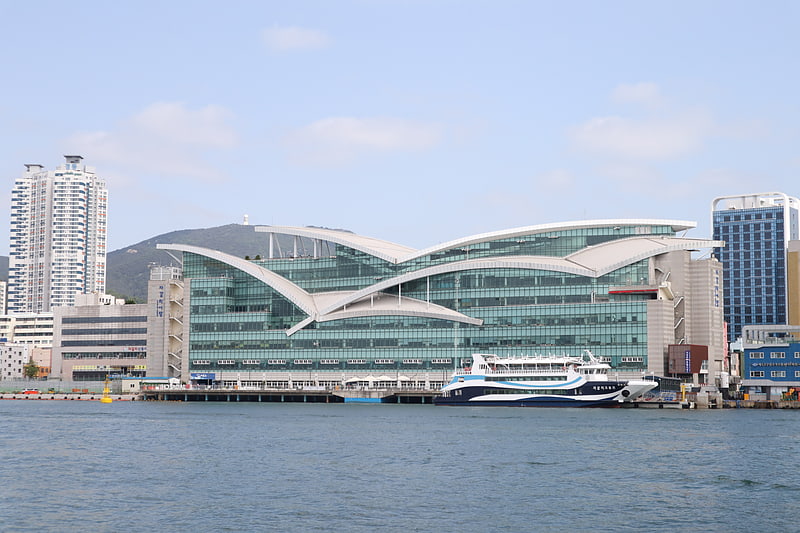
Also known as: 자갈치시장
The largest seafood market in Korea. Jagalchi Fish Market is a fish market in the neighborhood of Nampo-dong in Jung-gu, and Chungmu-dong, Seo-gu, Busan, South Korea. The market is located on the edge of Nampo Port, Busan. It is considered to be the largest fish market in South Korea.
The name is said to have originated from jagal (자갈 gravel in Korean) because the market used to be surrounded by gravel. This is one of the ten landmarks of Busan, so many tourists visit there to shop.
The market is known for the “Busan wives”. They are known for their strong will determination to provide financial support for their family and pay for their children’s education. Another name for these women is jagalchi ajumma. It references back to when these women would peddle the street selling goods after the Korean War. The market hosts the Busan Jagalchi Festival in autumn. The festival’s slogan is “Oiso! Boiso! Saiso!” (“Come! See! Buy!”). Individuals can participate in singing, dancing, catching fish, and eating fresh fish.
Various good are found in this market, which spans 3 kilometers. Near the Yeongdo Grand Bridge can be found dehydrated anchovies, sea laver, and various shellfish. Across from the city hall, shops sell herbal medicine and animal-based remedies.[1]
Address: Nampo-dong, Jung-gu, Busan (중구)
Beomeosa
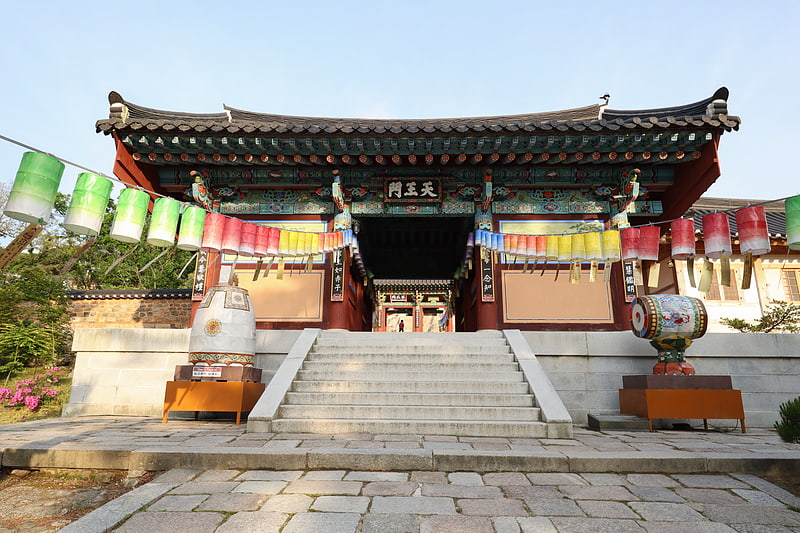
Also known as: 범어사
Temple in Busan, South Korea. Beomeosa is a head temple of the Jogye Order of Korean Buddhism in Cheongnyong-dong, Geumjeong-gu, Busan, South Korea. Built on the slopes of Geumjeongsan, it is one of the country's best known urban temples.[2]
Address: 금정구 범어사로 250, 609-844 부산광역시 (금정구)
Yongdusan Park
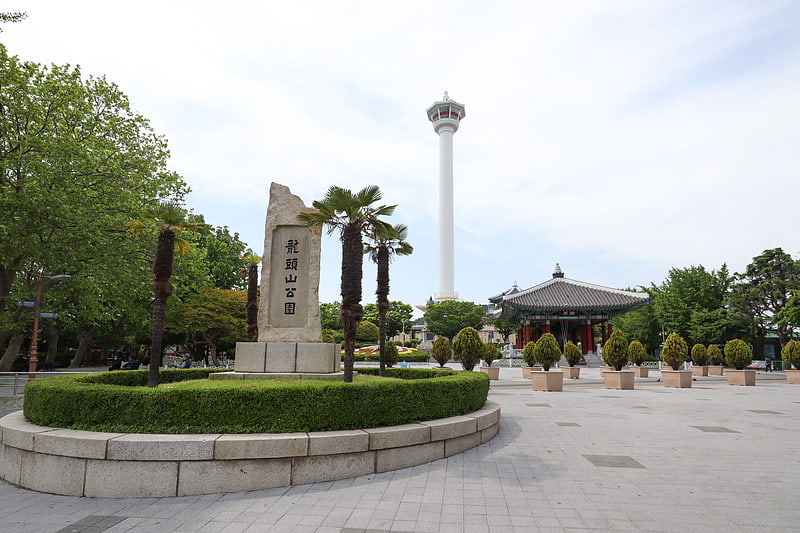
Also known as: 용두산공원
Mountain park with an observation tower. Yongdusan Park is a park located in Jung-gu, Busan, South Korea. The 120-meter-high Busan Tower is located here.
Yongdu means “dragon’s head” and “san” means “mountain”. The name is an allusion to the similarity of the mountain park, which is said to resemble a dragon’s head. The park occupies an area of 69,000 square meters. It has 70 different species of trees growing in it.[3]
Address: 37-55, Yongdusan-gil, Jung-gu, 48950 Busan (중구)
SEA LIFE Busan Aquarium
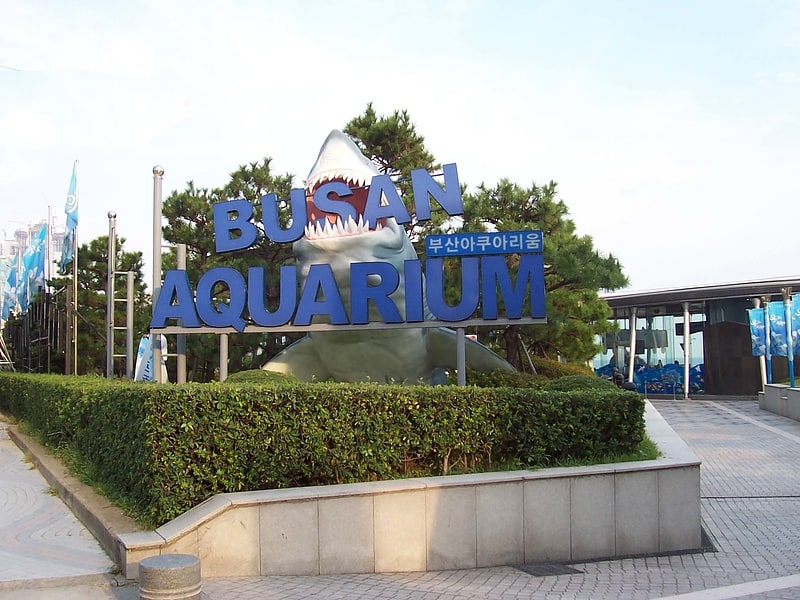
Also known as: 부산아쿠아리움
Aquarium in Busan, South Korea. Sea Life Busan Aquarium is an aquarium located in Haeundae Beach, South Korea.[4]
Address: 266, Haeundaehaebyeon-ro, Haeundae-gu, 48100 Busan (해운대구)
Haedong Yonggungsa
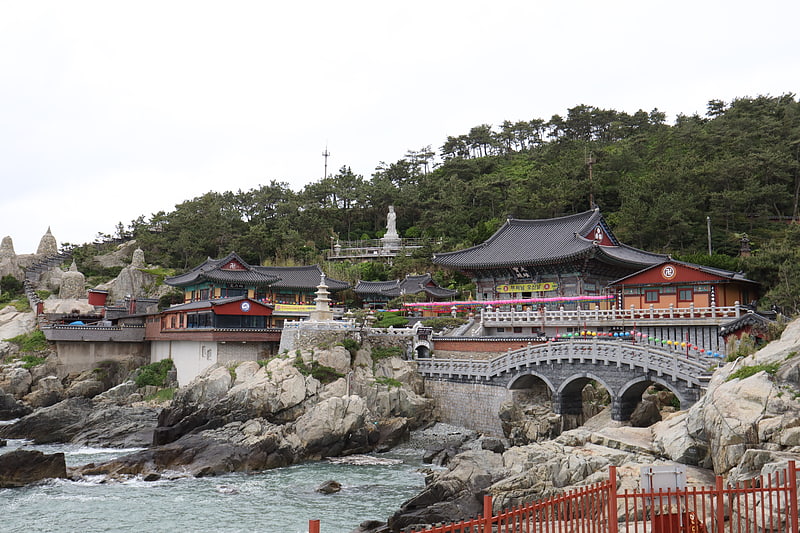
Also known as: 해동용궁사
Temple in Busan, South Korea. Haedong Yonggung Temple is a Buddhist temple in Gijang-gun, Busan, South Korea. The temple was built in 1376 by the teacher known as Naong during the Goryeo Dynasty, and was originally known as Bomun Temple. It was destroyed during the Japanese invasions of Korea but was rebuilt in the 1930s, and was renamed Haedong Yonggung Temple in 1974. The temple complex is a large one and one of few in Korea to be set on the seaside. As such, combined with its proximity to Haeundae Beach and the east side of Busan, the temple is popular with sightseers, particularly during Buddha's Birthday celebrations when the complex is decorated with paper lanterns.[5]
Address: 416-3, Sirang-ri, Gijangeup, Gijang-gun, 619-902 Busan (기장군)
Gamcheon Culture Village
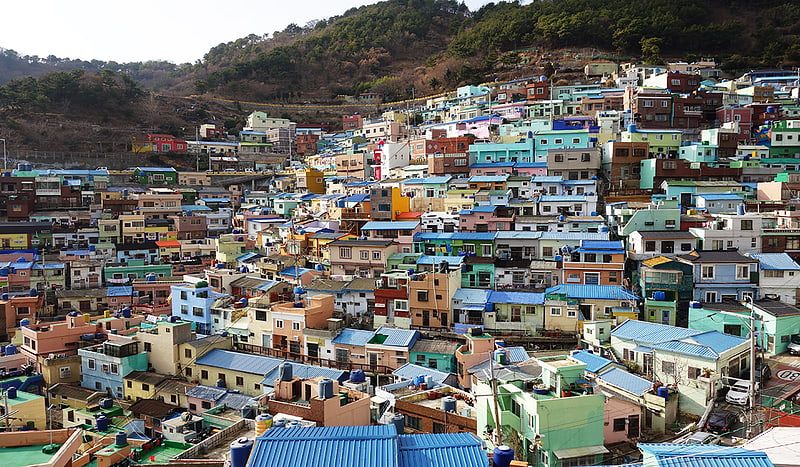
Gamcheon Culture Village is a town within Gamcheon-dong, Saha District, Busan, South Korea. The area is known for its layered streets, twisted labyrinth-like alleys, and brightly painted houses, which have been restored and enhanced in recent years to attract tourism. Built on a steep mountain-side slope, the village has been nicknamed "Korea's Santorini," as well as the "Machu Picchu of Busan".[6]
Busan Tower
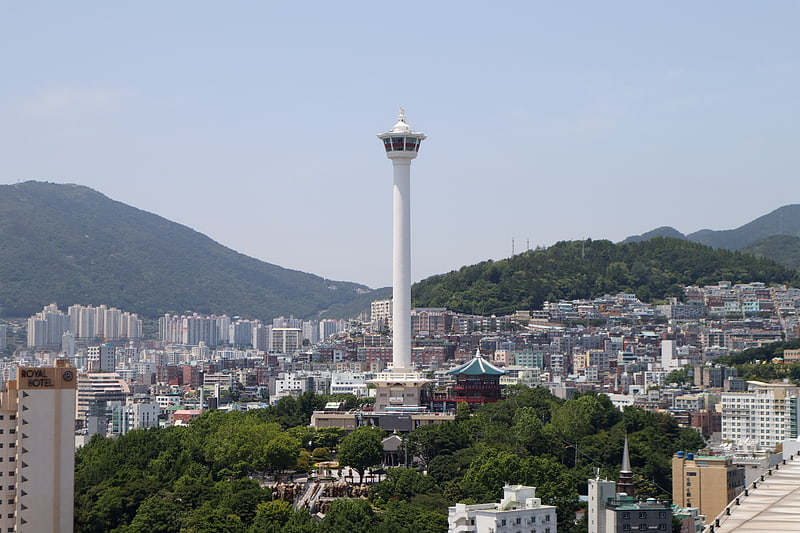
Also known as: 부산타워
Soaring tower with a viewing deck. Busan Tower is a 120-metre-high tower at Yongdusan Park, located in Jung-gu, Busan, South Korea.
Busan Tower was built in 1973. It's only used for entertainment purposes and doesn't have any transmitting equipment which sets the tower apart from many other towers with observation decks primarily built as TV- and radio towers. The deck features panoramic view and a small cafe, it's only accessible during working hours via two high-speed elevators. The base of the tower is interconnected with a few galleries and souvenir shops. The tower is usually mentioned in tourist guides as a good place to get a view of the city's port.[7]
Address: 37-30, Yongdusan-gil, Jung-gu, 48950 Busan (중구)
United Nations Memorial Cemetery
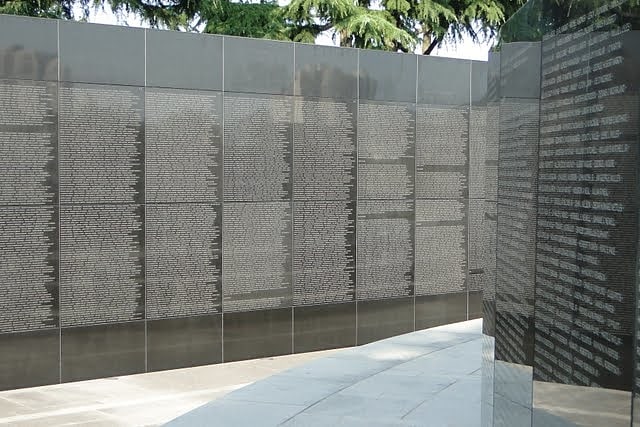
Also known as: 유엔기념공원
Cemetery in Busan, South Korea. The United Nations Memorial Cemetery in Korea, located at Tanggok in the Nam District, City of Busan, Republic of Korea, is a burial ground for United Nations Command casualties of the Korean War. It contains 2,300 graves and is the only United Nations cemetery in the world. Laid out over 14 hectares, the graves are set out in 22 sites designated by the nationalities of the buried servicemembers.[8]
Address: 93, UN pyeonghwa-ro, Nam-gu, 48529 Busan (남구)
Busan Museum
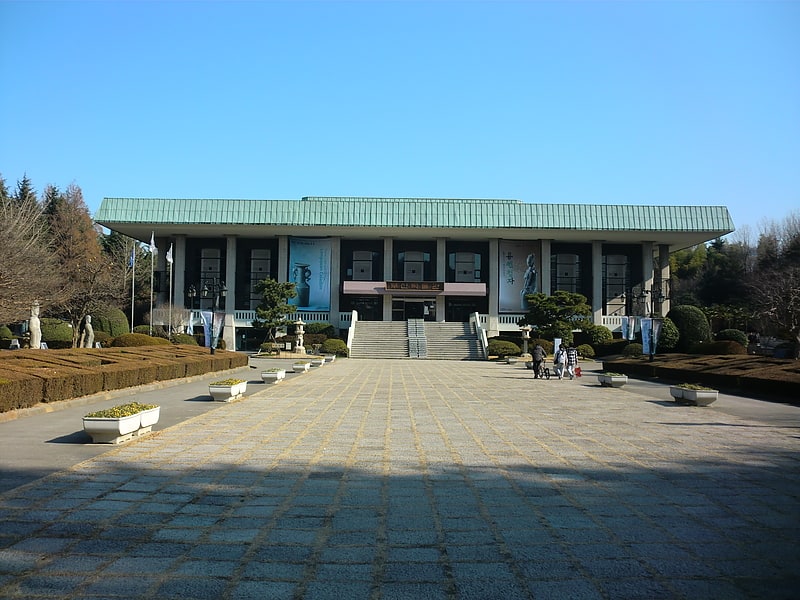
Also known as: 부산광역시립박물관
Museum in Busan, South Korea. Busan Museum is a museum located in Busan, South Korea, open since 1978.[9]
Address: 63 UN pyeonghwa-ro, Daeyeon 4(sa)-dong, 608-020 Nam-gu (남구)
Busan Cinema Center
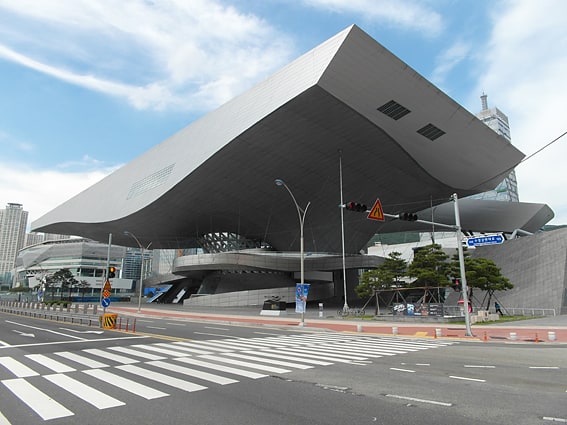
Also known as: 영화의전당
Performing arts theater in Busan, South Korea. The Busan Cinema Center is the official, exclusive venue of the Busan International Film Festival, where its opening and closing ceremonies take place, located in Centum City, Busan, South Korea. The about US$150 million center opened on September 29, 2011, almost three years after construction began. The building won the International Architecture Award and the Chicago Athenaeum in 2007. As of July 2013, it has the Guinness World Record for the longest cantilever roof. The center was designed by the Austrian architectural design firm Coop Himmelbau and constructed by Hanjin Heavy Industries.[10]
Address: Busan, 120 Suyeonggangbyeon-daero, Haeundae-gu
Busan Cooperative Fish Market

Also known as: 부산공동어시장
The Busan Cooperative Fish Market, or BCFM, is the largest fish market in South Korea. It adjoins the South Harbor in Busan. More than 30% of the country's fish production passes through the market. In recent years, a large percentage of the catch has been made up of yellowtail, due to warming waters in the Sea of Japan. The market occupies an area of 166,420 m2, of which about 10% is a refrigerated working area.
The market first opened on November 1, 1963, at the present-day site of the Busan International Ferry Terminal. It moved to its present location in 1973.[11]
Address: 광진구 동일로78길 52, 626-171 부산광역시 (서구)
Sajik Baseball Stadium

Also known as: 사직야구장
Stadium in Busan, South Korea. The Busan Sajik Baseball Stadium is a baseball stadium in Sajik-dong, Dongnae-gu, Busan, South Korea. It was built in 1985 and is the home stadium of KBO club Lotte Giants. It has a seating capacity of 24,500. It is known as a mecca for Korean baseball.
The stadium can be accessed via Sajik Station which is on Busan Metro Line 3.[12]
Address: 45, Sajik-ro, Dongnae-gu, 47874 Busan (동래구)
Jangsan Mountain
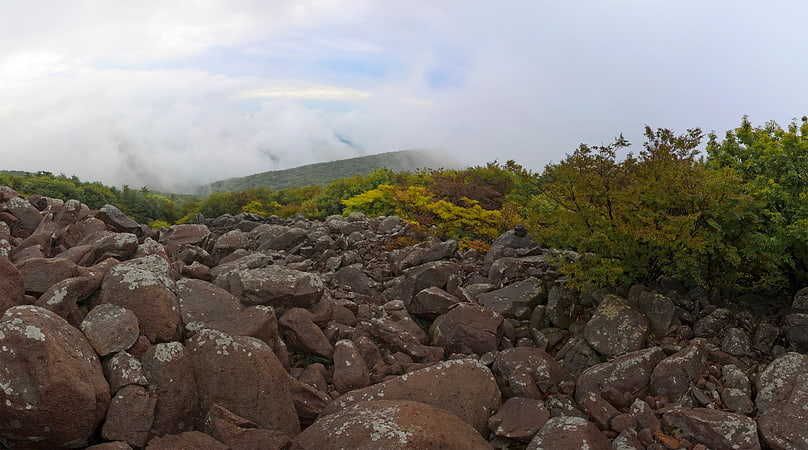
Mountain in South Korea. Jangsan is a mountain of South Korea. It has an elevation of 634 metres Jangsan is located in Haeundae-gu in Busan. Signs posted indicate that an active land mine field is located on the mountain.[13]
Gukje Market
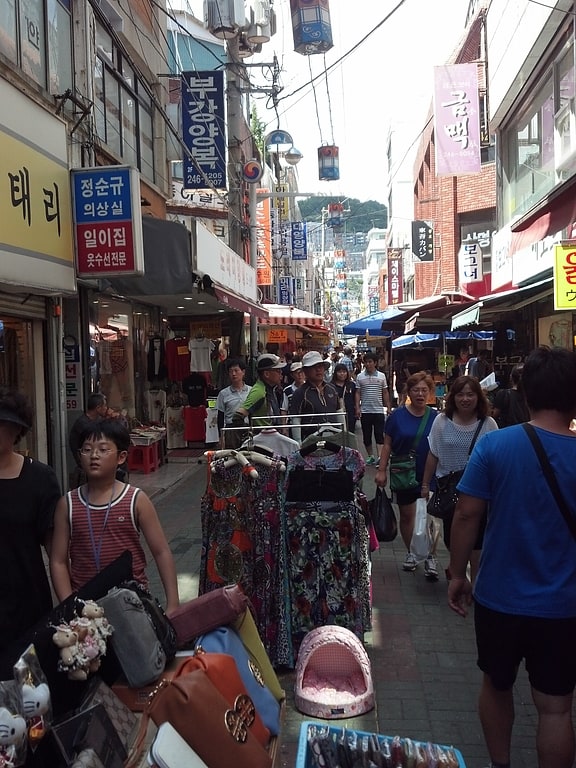
Also known as: 국제시장
Market in Busan, South Korea. Gukje Market or Nampodong International Market is a market in Sinchang-dong, Jung District, Busan, South Korea. It opens from 9:30am to 7:30pm.[14]
Address: 중구 중구로 36, 48945 부산광역시 (중구)
Korea National Maritime Museum
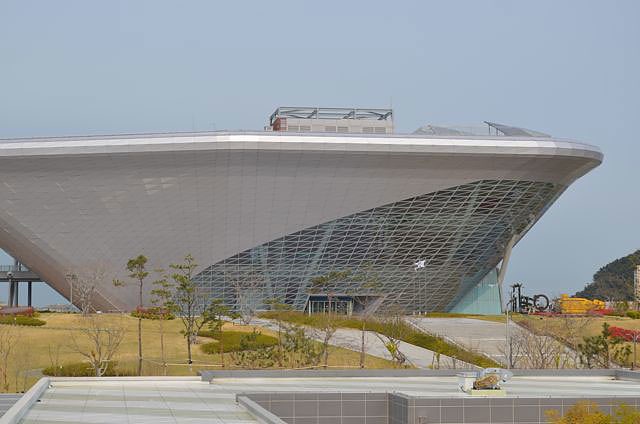
Also known as: 대한민국 국립해양박물관
Museum in Busan, South Korea. The Korea National Maritime Museum is a Korean maritime museum and the third largest museum in the Republic of Korea. The museum was inaugurated on July 9, 2012, and is located in Dongsam-dong, Yeongdo-gu, Busan.
The museum exhibits more than 12,000 maritime relics, including the ‘Joseon Missional Ship’ which is the largest replica in South Korea - half the size of the actual ship.[15]
Address: 45 Haeyang-ro 301beon-gil, Dongsam 1(il)-dong, 606-080 Yeongdo-gu (영도구)
Gwangan Bridge
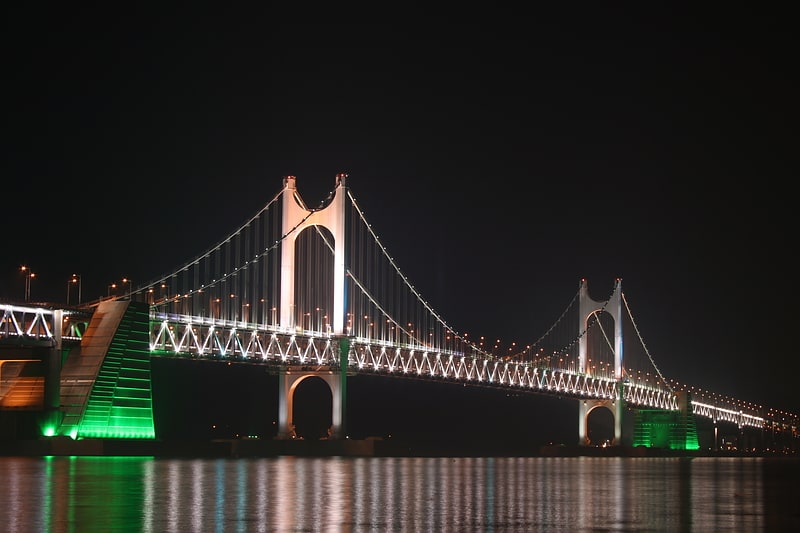
Also known as: 광안대교
Modern suspension bridge spanning 7km. The Gwangandaegyo or Diamond Bridge is a suspension bridge located in Busan, South Korea. It connects Haeundae-gu to Suyeong-gu. The road surface is about 6,500 meters long, with the bridge as a whole spanning 7,420 meters. It is the second longest bridge in the country after the Incheon Bridge.
Construction began in 1994 and concluded in December 2002, with a total cost of 789.9 billion won. The bridge opened temporarily in September and October 2002 for the 2002 Asian Games. However, it was not officially opened until January, 2003.[16]
Address: 수영구 광안대로, Busan
Busan Modern History Museum
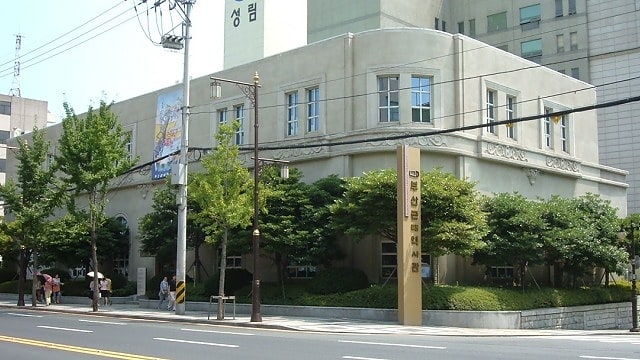
Also known as: 부산근대역사관
Museum in Busan, South Korea. The Busan Modern History Museum is a museum in Busan, South Korea.
The building was originally constructed during the Japanese occupation of Korea for the Oriental Development Company an organisation used to support Japanese colonization of Korea. Following the liberation of Korea in 1945 it was later used as the United States Information Service and was the site of the Busan American Cultural Service building arson during student protests in 1982.[17]
Address: 104, Daecheong-ro, Jung-gu, 48949 Busan (중구)
Taejongdae
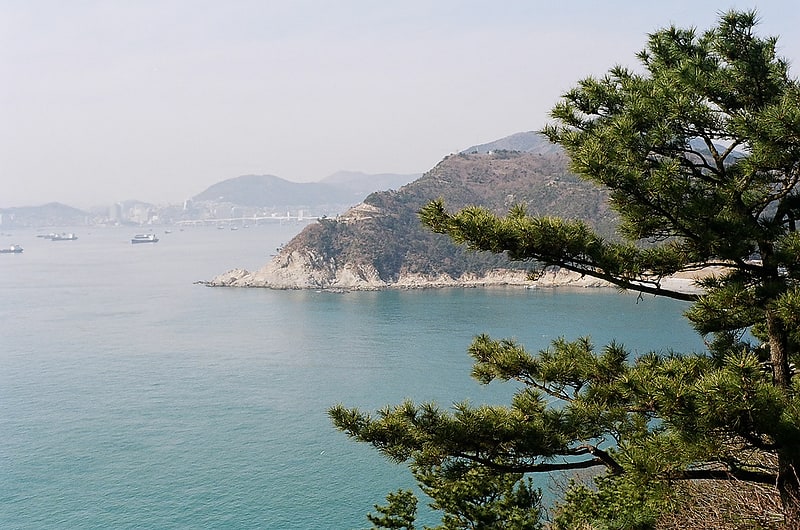
Also known as: 태종대
Elevated park with a seaside observatory. Taejongdae is a natural park of Busan, South Korea with magnificent cliffs facing the open sea on the southernmost tip of island of Yeongdo-gu. It is a representative visitor attraction of Busan that has dense evergreen trees and several facilities for tourists such as an observatory, an amusement park, a light house, a cruise ship terminal. It is said that its name to have taken from King Taejong Muyeol, the 29th king of the Silla Kingdom who liked to practice archery there after the unification of the Three Kingdoms of Korea. Taejongdae is designated as the 28 Busan monument, along with Oryukdo Island.[18]
Address: 257, Jeonmang-ro, Yeongdo-gu 부산광역시 영도구 전망로 24 (동삼동), Busan
BEXCO
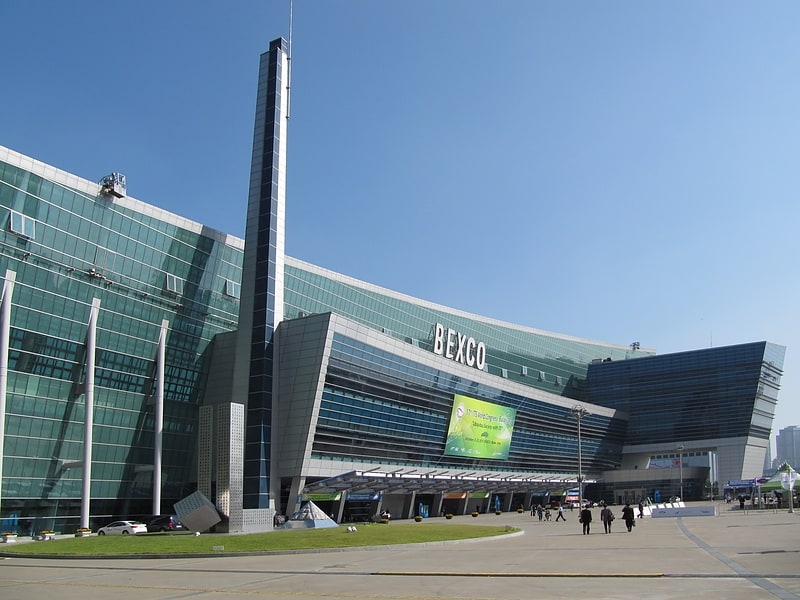
Also known as: 벡스코
Convention center in Busan, South Korea. Busan Exhibition and Convention Center, commonly known as BEXCO, is a convention and exhibition center located in Centum City, Haeundae-gu, Busan, South Korea. It features over 46,500㎡ of exhibition space and 53 meeting rooms. In June 2012, BEXCO completed its expansion to add a 4,002-seat auditorium and a new exhibition center.
BEXCO has hosted a variety of events, notability as a concert venue for Koreans as well as international artists, such as Grammy Award winners Michael Bolton and Dr. Dre.[19]
Address: 해운대구 APEC로 55, 48060 부산광역시 (해운대구)
Busan Asiad Main Stadium
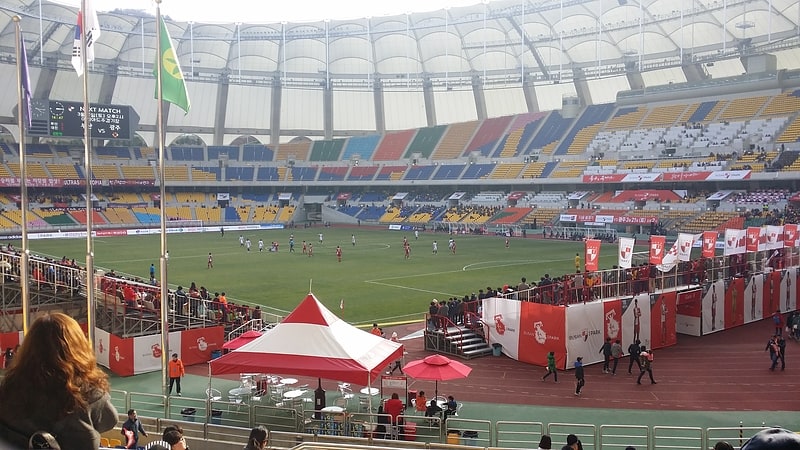
Also known as: 부산아시아드주경기장
Multi-purpose stadium in Busan, South Korea. Busan Asiad Stadium or Asiad Main Stadium is a multi-purpose stadium in Busan, South Korea, that was built for the 2002 Asian Games and was also used for matches at the 2002 FIFA World Cup. It has a capacity of 53,769. The stadium hosted the opening and closing ceremonies of the 2002 Asian Games and was also the venue of athletics events during the games.[20]
Address: 연제구 월드컵대로 344, 47500 부산광역시 (연제구)
40–step stairway

Also known as: 40계단
The 40–step stairway is a historic stairway in the Jung District of Busan, South Korea. It sits at one end of the 40-step Culture & Tourism Theme Street, which is a tourist attraction intended to recall the history of the area and in particular its importance to refugees during and after the Korean War. The staircase itself was known as a common location for refugees to seek reunification with their families and friends, given the lack of functional communications during the War. The 40–step stairway appears in the film Nowhere to Hide.[21]
WBC The Palace
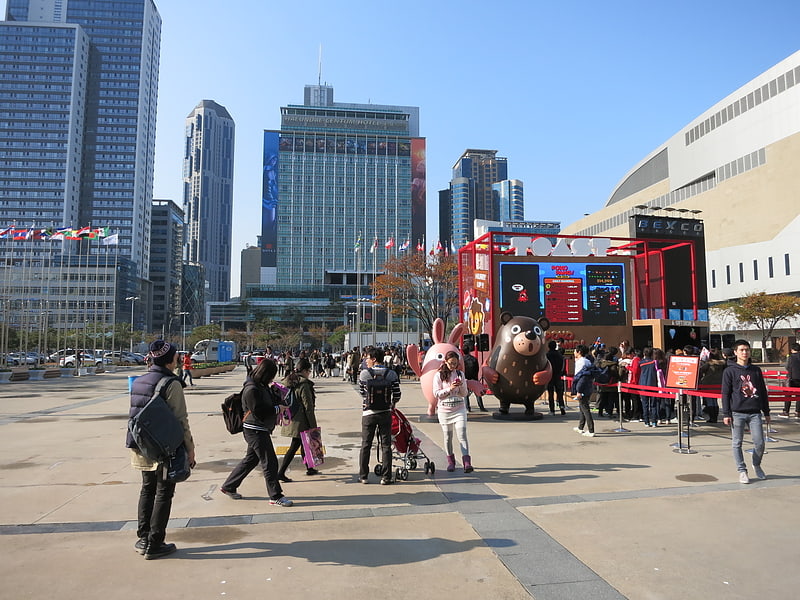
Building complex in Busan, South Korea. WBC The Palace is a complex of two residential skyscrapers in Busan, South Korea consisting of three office towers and one residential tower. Tower 1 and 2 were both completed in 2011.[22]
Chungnyeolsa
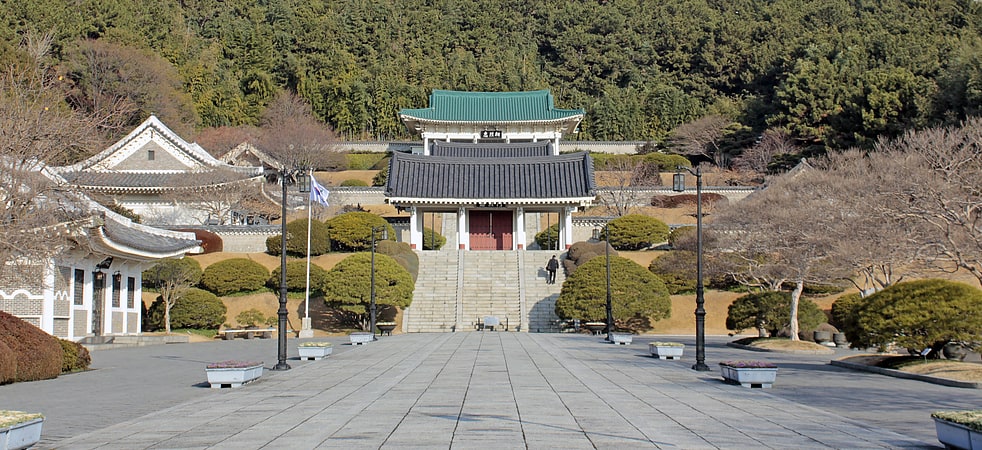
Also known as: 충렬사
Shrine in Busan, South Korea. Chungnyeolsa is a sacred shrine, where the spirits of those who fought against the Japanese troops during the Japanese invasions of Korea of 1592, are enshrined.
The present Chungnyeolsa was first built in 1605 (the 38th year of the reign under King Seonjo) as Songgongsa, within the South Gate of Dongnae eupseong by Yun Hwon, the Deputy Delegate of Dongnae, enshrining Song Sang-hyeon and performing annual rite to the spirit. Then, in 1624 (the 2nd year of the reign under King Injo), with the suggestion of Lee Min-goo, the name of the temple was changed to Chungnyeolsa, also enshrining the spirit of Jeong Bal, a patriot who died a heroic death at Busanjin Fortress.
Then, in 1625 (the 3rd year of the reign under King Injo), Chungnyeolsa was moved to the current location, and named Allak Seowon with the construction of an auditorium and Dongseojae, in order to pass the loyalty and the academic conducts of the ancestors, serving both the functions of a temple house and a library.
In 1709 (the 35th year of the reign under King Sukjong), a separate building was built at the original location of Songgongsa, in memory of Jo Yeong-gyu (the Country Governor of Yangsan-gun), No Gae-bang (the Dongnae Kyosoo), Mun Deok-gyeom (a Confucian scholar), Yang Jo-han, Song Bong-su (the Bijang), Kim Hui-soo (the Military Commander), Sin Yeo-ro (a steward), Song Baek (the Hyangni) and Kim Sang (a common man), etc. all of whom dies bravely with Song Sang-hyeon and Jeong Bal.
In 1736 (the 12th year of the reign under King Yeongjo), the ones enshrined at the separate buildings were all enshrined together at Chungnyeolsa, and in 1772 (the 48th year of the reign under King Yeongjo), Yun Heung-sin, the Dadaecheomsa, was also enshrined here, while a sanctuary was built outside the East Gate of Chungnyeolsa, in memory of Geumseom and Aehyang, each of whom died after Song Sang-hyeon and Jeong Bal.
Chungnyeolsa went through more remodeling and restoration thereafter, and is currently composed of 16 buildings including the main hall in a total area of 93,448㎡. Approximately 92 memorial tablets are enshrined in memory of those who died bravely and patriotically in Busan region, fighting against the Japanese troops. A sacrificial rite is performed on May 25 annually, with the gratitude and the hearts of the citizens of Busan Metropolitan City.[23]
Address: 345, Chungnyeol-daero, Dongnae-gu, 607-100 Busan (동래구)
Yeongdo Bridge
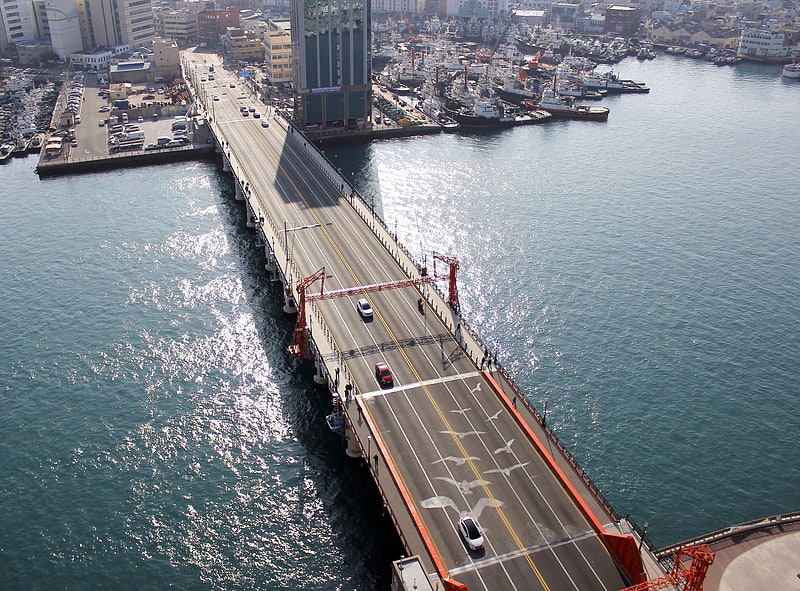
Also known as: 영도대교
Bascule bridge. Yeongdodaegyo A.K.A. Yeongdodari is a bascule bridge in Yeongdo, Busan, Republic of Korea. It is also called Yeongdo Bridge in English. Completed in 1934, it connects Jung District ward on Busan mainland to Yeongdo District on the Yeongdo Island spanning the south port of Busan. During the Korean War, the bridge served as a site where people went to find lost family members and friends. The original drawbridge stopped functioning in 1966. It was deemed dangerous in 2003 and almost torn down, but was ultimately designated a historical monument. The drawbridge was restored and re-opened on November 27, 2013.[24]
Address: 영도구 태종로 40, Busan
Gamcheon-dong
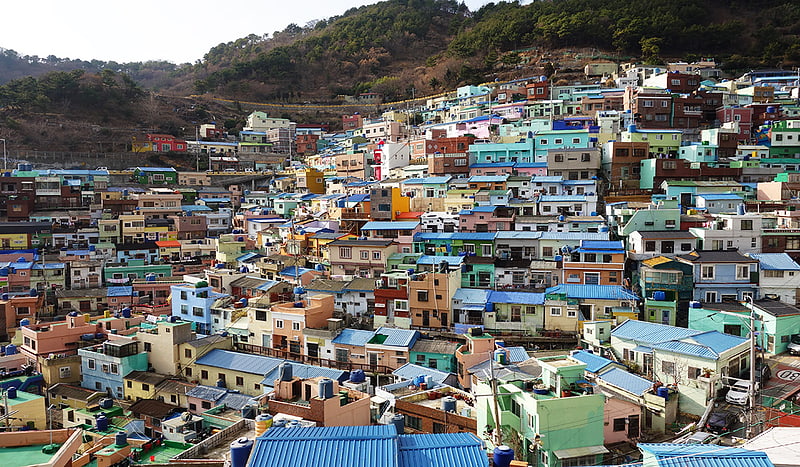
Gamcheon-dong is a subdivision of Saha-gu district in central-west Busan, South Korea. Gamcheon Culture Village, which features steep streets, twisting alleys, and brightly painted houses, is located in Gamcheon-dong. Some painted street murals, art installations, cafes, stores, museums, workshops, and craft boutiques have also sprung up in the area. The area was previously known as Taegeukdo Village.
Previously one of the city's poorer areas, the government of Korea invested money in Gamcheon-dong in 2009 to fund the "Dreaming of Machu Picchu in Busan Project". Subsequently the area has won several regional awards including the 2012 UN-HABITAT Asian Townscape Award and a cultural excellence award from Korea's Ministry of Culture, Sports and Tourism.[25]
Busan Marine Natural History Museum
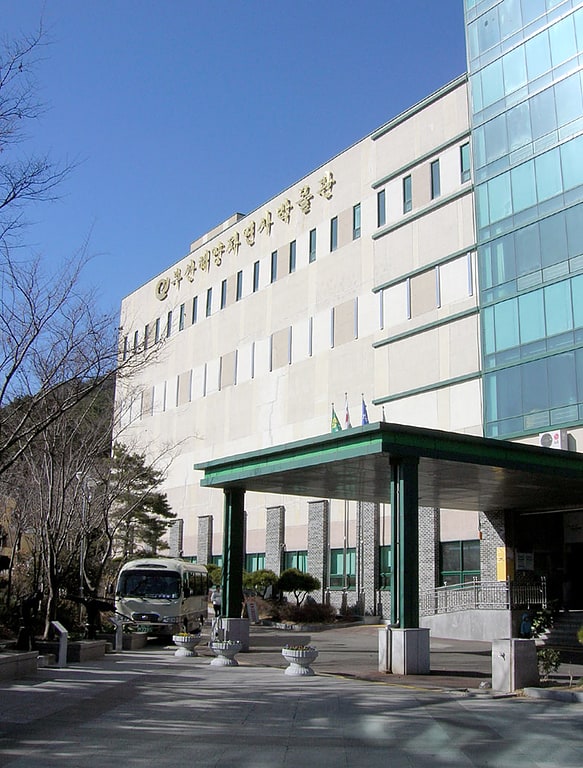
Also known as: 부산해양자연사박물관
Museum. The Busan Marine Natural History Museum is a museum displaying exhibits on marine natural history of Busan and located in Dongnae-gu, Busan. It was founded in 1994. The purpose of the foundation is to preserve, to study and to exhibit geological and biological records about the local environment.[26]
Address: San 13-1, Oncheon-dong, Dongnae-gu, 607-060 Busan (동래구)
Renault Samsung Motors Gallery

Also known as: 르노삼성자동차 갤러리
Museum. The Renault Samsung Motors Gallery is a museum owned by the Korean carmaker Renault Samsung Motors.
The museum was opened as the Reuno Samseong Munhwagwan (Hangul:르노삼성 문화관) or Renault Samsung Culture Center in June 2001. It was renovated in September 2006, adopting its current name. For its tenth anniversary were made further improvements.
The facilities feature SM7 / QM5 cutaway models to display, cutaway engines (M9R diesel, VQ, etc.), previous and special models (SM5, SM3, Seoul Motor Show exhibition cars, etc.) and diagrams of production process. The museum also displays various projects of the Renault-Nissan Alliance.
There are several road safety programs targeted at children. The museum has a page where can be made virtual tours through the factory. There also are guided factory tours which must be reserved.[27]
Dongnaeeupseong

Also known as: 동래읍성지
Historical place in Busan, South Korea. The Dongnaeeupseong Fortress is located on Dongnae-gu, Busan Metropolitan City, Republic of Korea.
Traditionally In Korea, a wall-fortress was erected in each town to keep it safe from invasions. In this area called Dongnae, there were some borough-states after the Samhan period (the 1st century BC), Geochilsanguk, Chilsanguk, Jangsanguk and Dongnoguk states are told to have been included among these. It is believed that walls had been already built here at that time.
However, the first mention about the Dongnaeeupseong Fortress that appears in historical records is that the wall was repaired in 1021, the twelfth year of the reign of King Hyeonjong of Goryeo Dynasty.
Since the Japanese began their invasions into Korea on April 14, 1592, this Dongnaeeupseong Fortress, along with the Busanjinseong Fortress, became the first target by the Japanese. Siege of Dongnae ensued here, in which General Song Sang-hyeon and all the other officials, troops and common people lost their lives.
The Fortress was repaired and expanded in 1713, extending its circumference to 5,240 meters. It had four gates: Jihuiru (east), Simseongnu (west), Muuru (south), and Eunillu (north). A wing fortress was built upon the south gate and small fortifications were erected on the other three gates too. At present, there are some restored structures inside the wall, including the north gate with a fortification on its top, Dongjangdae and Seojangdae, and Bukjangdae, Insaengmun (Gate), Chiseong wall and a fortified small wall surrounding a gate.[28]
Gwangalli Beach
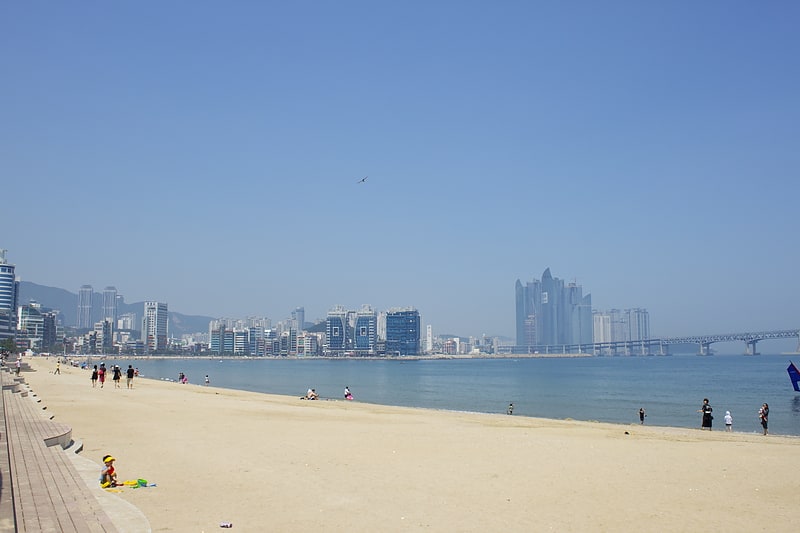
Also known as: 광안리해수욕장
Beach with tiki umbrellas and bridge views. The Gwangalli Beach or Gwangan Beach is a beach in Busan, South Korea. It is located at Gwangan 2-dong, Suyeong-gu, Busan Metropolitan City, west of Haeundae Beach. It sits inside a cove spanned by the Gwangan Bridge and covers 82,000 square meters over a length of 1.4 km and a width of 25 to 110 metres, in a curved in a half-moon shape with fine sand. Adjacent are alleys with restaurants, coffee shops and nightclubs. Because of its popularity, city officials are pushing for improving water quality around the beaches.
The beach is near the Busan Yachting Center used for the sailing events of the 1988 Summer Olympics.
For the 2018 film Black Panther, a car chase scene which required over 150 cars and 700 people was filmed in the Gwangalli Beach area.[29]
Haeundae Beach
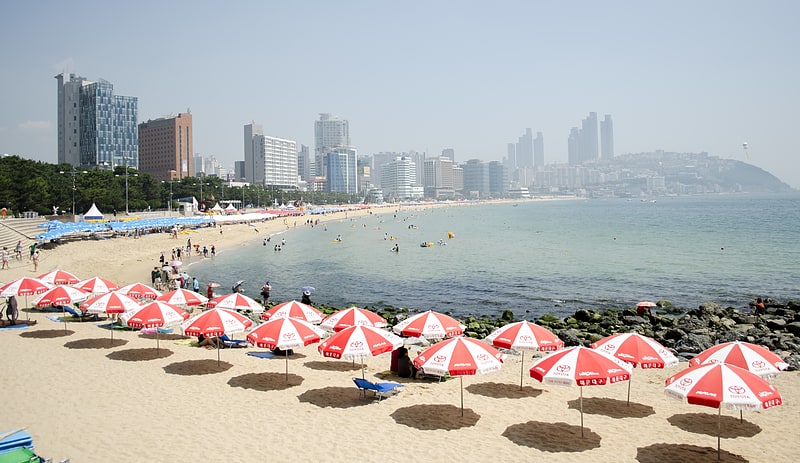
Also known as: 해운대해수욕장
Beach in Busan, South Korea. Haeundae Beach is an urban beach in Busan, South Korea. Often dubbed one of the country's most famous and popular beaches, it is located in the eponymous Haeundae District.
The beach is open year-round, and various festivals are held there throughout the year. A popular beach event, "Polar Bear Club", during which participants bath in near freezing water, has been held annually since 1988 in January. The beach also features a number of e-sports events designed to promote Blizzard games including StarCraft.
Haeundae is closely associated with cinema, as it partly hosts the Busan International Film Festival, and was featured prominently in the 2009 disaster film Tidal Wave.[30]
Busan Bridge
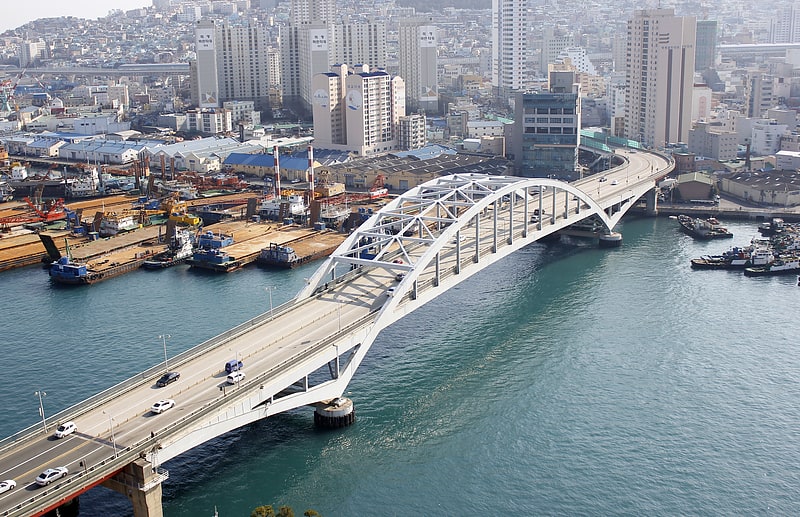
Also known as: 부산대교
Bridge in Busan, South Korea. Busandaegyo is a bridge in Busan, South Korea. The bridge connects the districts of Yeongdo District and Jung District. The bridge was completed in 1980.[31]
Busan Al-Fatah Mosque
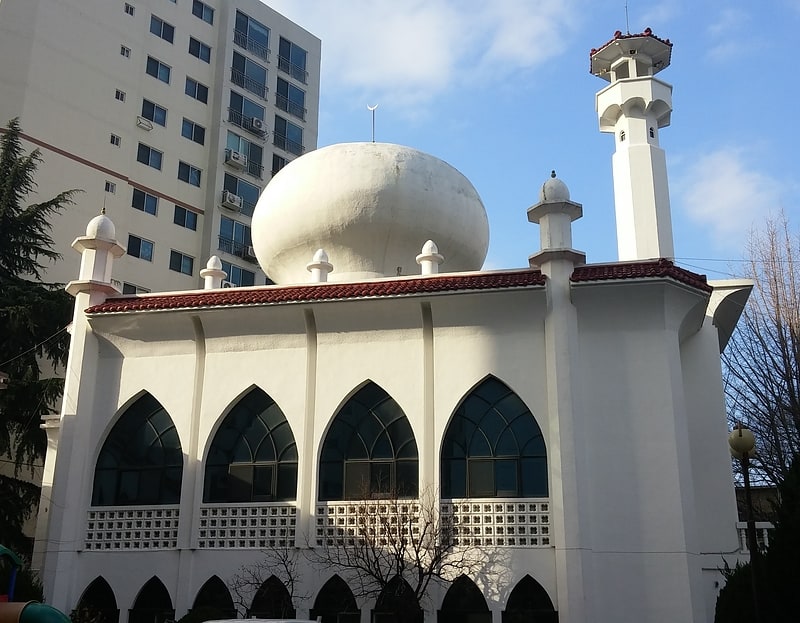
Mosque in Busan. The Busan Al-Fatah Mosque is a mosque in Namsan-dong, Geumjeong District, Busan, South Korea.[32]
Busanjinseong
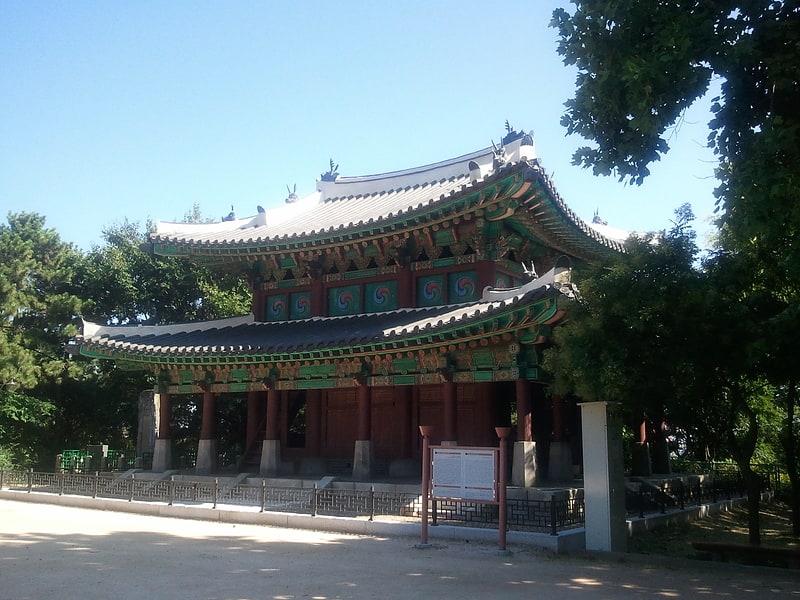
Also known as: 부산진지성
Castle in Busan, South Korea. The Branch Wall-fortress in Busanjin is located at Beomil-dong, Dong-gu, Busan Metropolitan City, the Republic of Korea.The existing wall-fortress remains were constructed by the Japanese military during the Japanese invasion of Korea. There are two assertions on the name of Jaseong. One is that the wall-fortress on the current Mt. Jeungsan, Jwacheon-dong is the mother castle and accordingly called Jaseong. The other is that Jaseong was constructed on the mountain top as the General's terrace.
The Busanjinjiseong Fortress was also called Mangongdae in memory of Ming-dynasty General Wan Shide who stayed at Jaseongdae to reinforce the Korean soldiers defending against the Japanese invasions of Korea (1592–98). The wall-fortress was repaired after General Wan Shide returned home.[33]
Address: 99, Jaseong-ro, Dong-gu, Busan (동구)
Namhang Bridge
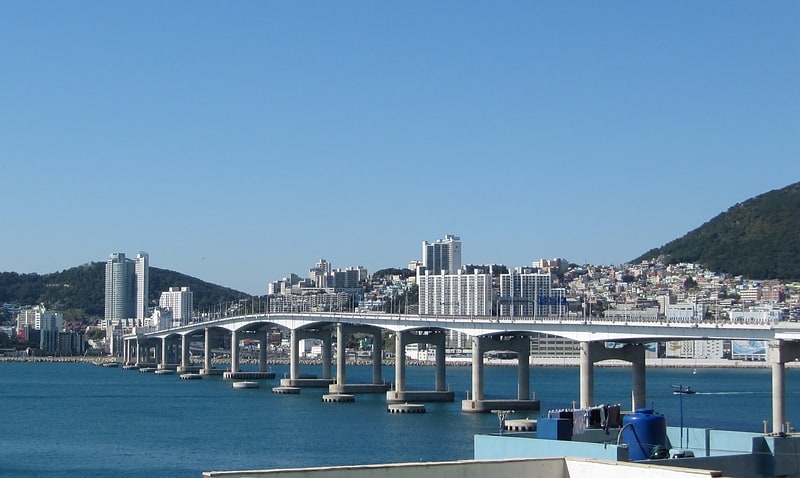
Also known as: 남항대교
Girder bridge in Busan, South Korea. Namhangdaegyo is a girder bridge in Busan. It spans Yeongdo-gu and Seo-gu and is 1.8 km long in total with four lanes of traffic.[34]
Haeundae LCT The Sharp
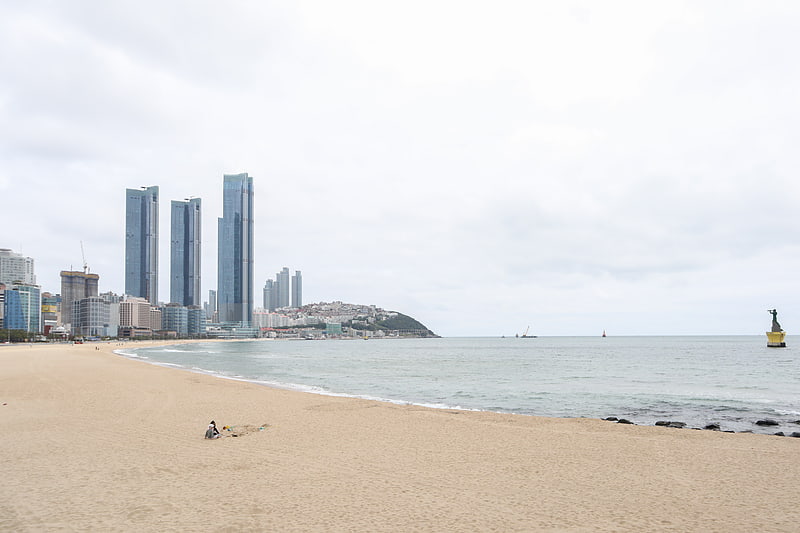
Building complex in Busan, South Korea. Haeundae LCT The Sharp is a major urban development project under in Jung-dong, Haeundae District, Busan, South Korea. Located in front of Haeundae Beach, it consists of a 411.6 m, 101-floor supertall landmark tower and two 85-floor tall residential skyscrapers. It has an urban entertainment complex at the base housing a shopping mall, a hot spring spa and a water park. The landmark tower will house luxury and residential hotels with a convention center and an observatory.
As of July 8, 2018, 101-storey Land mark tower 90s floor level and twin 85-storey residential towers at 80s level structures completion. Busan's 2nd-4th mega tall Skyscraper after first 301m Haeundae Doosan We've the Zenith. LCT tower is the tallest tower in South Korea after 555m Lotte World Tower in Seoul.
Construction was planned for 2007 and groundbreaking was held in October 28 2013 and completion is scheduled for 2019. It was voted to have the second nicest toilet in South Korea.
Haeundae LCT the sharp Is one of the greatest tower in the world
Haeundae LCT The Sharp was completed and opened in 30 November 2019.[35]